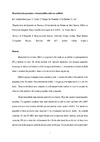Please use this identifier to cite or link to this item:
https://accedacris.ulpgc.es/jspui/handle/10553/42002
| Title: | 3D printed polycaprolactone-microcrystalline cellulose scaffolds | Other Titles: | Three-dimensional printed polycaprolactone-microcrystalline cellulose scaffolds | Authors: | Alemán-Domínguez, Maria Elena Giusto, Elena Ortega, Zaida Tamaddon, Maryam Benítez, Antonio Nizardo Liu, Chaozong |
UNESCO Clasification: | 3313 Tecnología e ingeniería mecánicas | Keywords: | Tissue Engineering Ingeniería de tejidos Regeneración de hueso Bone replacement |
Issue Date: | 2019 | Project: | Biomaterials And Additive Manufacturing: Osteochondral Scaffold Innovation Applied To Osteoarthritis | Journal: | Journal of Biomedical Materials Research - Part B Applied Biomaterials | Abstract: | Microcrystalline cellulose (MCC) is proposed in this study as an additive in polycaprolactone (PCL) matrices to obtain 3D printed scaffolds with improved mechanical and biological properties. Improving the mechanical behavior and the biological performance of polycaprolactone-based scaffolds allows to increase the potential of these structures for bone tissue engineering. Different groups of samples were evaluated in order to analyse the effect of the additive in the properties of the PCL matrix. The concentrations of MCC in the groups of samples were 0, 2, 5 and 10% (w/w). These combinations were subjected to a thermogravimetric analysis in order to evaluate the influence of the additive in the thermal properties of the composites. 3D printed scaffolds were manufactured with a commercial 3D printer based on fused deposition modelling. The operation conditions have been established in order to obtain scaffolds with a 0/90° pattern with pore sizes between 450-500 µm and porosity values between 50-60%. The mechanical properties of these structures were measured in the compression and flexural modes. The scaffolds containing 2% and 5% MCC have higher flexural and compression elastic modulus, although those containing 10% do not show this reinforcement effect. On the other hand, the proliferation of sheep bone marrow cells on the proposed scaffolds was evaluated over 8 days. The results show that the proliferation is significantly better (p<0.05) on the group of samples containing 2% MCC. Therefore, these scaffolds (PCL:MCC 98:2) have suitable properties to be further evaluated for bone tissue engineering applications. | URI: | https://accedacris.ulpgc.es/handle/10553/42002 | ISSN: | 1552-4973 | DOI: | 10.1002/jbm.b.34142 | Source: | Journal of Biomedical Materials Research - Part B Applied Biomaterials[ISSN 1552-4973], v. 107 (3), p. 521-528 |
| Appears in Collections: | Artículos |
SCOPUSTM
Citations
53
checked on Jun 8, 2025
WEB OF SCIENCETM
Citations
49
checked on Jan 18, 2026
Page view(s)
323
checked on Jan 16, 2026
Download(s)
549
checked on Jan 16, 2026
Google ScholarTM
Check
Altmetric
Share
Export metadata
Items in accedaCRIS are protected by copyright, with all rights reserved, unless otherwise indicated.
